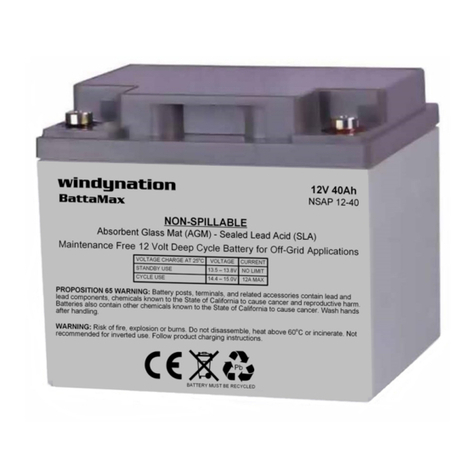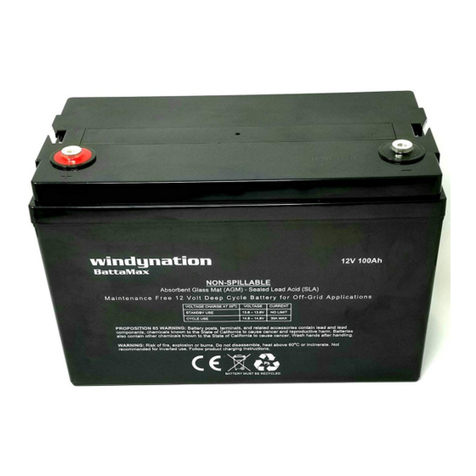WINDY NATION BAT-LFP12-100 User manual

BattaMax Lithium User Manual
Revision 1.0
Page 1 of 14
windynation
11/14/2022
windynation
BattaMax Lithium
Lithium Iron Phosphate (LiFePO4) – Deep Cycle SMART Battery
BAT-LFP12-100
User’s Manual

BattaMax Lithium User Manual
Revision 1.0
Page 2 of 14
windynation
11/14/2022
Table of Contents
1Introduction ..................................................................................................................................................3
1.1 Safety ...................................................................................................................................................... 3
1.2 Definitions................................................................................................................................................3
2Product Overview.........................................................................................................................................3
2.1 Features .................................................................................................................................................. 4
2.2 Applications............................................................................................................................................. 4
2.3 Specifications ..........................................................................................................................................4
2.3.1 Electrical Specifications.......................................................................................................................4
2.3.2 Physical Specifications........................................................................................................................4
3Installation....................................................................................................................................................4
3.1 Environment ............................................................................................................................................ 5
3.1.1 Temperature........................................................................................................................................5
3.2 Connections............................................................................................................................................. 5
3.2.1 Wire Gauge Reference........................................................................................................................ 5
3.2.2 Threaded Terminals ............................................................................................................................ 5
3.3 Configuration........................................................................................................................................... 6
3.3.1 Series Connection............................................................................................................................... 6
3.3.2 Parallel Connection .............................................................................................................................6
3.3.3 Series-Parallel Connection..................................................................................................................7
4Service and Maintenance ............................................................................................................................7
4.1 Charging.................................................................................................................................................. 7
4.1.1 State of Charge (SOC)........................................................................................................................7
4.1.2 Cell Balancing......................................................................................................................................7
4.1.3 Temperature Compensation................................................................................................................ 8
4.2 Discharging.............................................................................................................................................. 8
4.2.1 Cycle Life versus Capacity..................................................................................................................8
4.3 Maintenance............................................................................................................................................ 8
5Battery Management System (BMS) ...........................................................................................................9
5.1 BMS Application...................................................................................................................................... 9
5.1.1 iPhone .................................................................................................................................................9
5.1.2 Android ..............................................................................................................................................10
5.2 BMS Settings.........................................................................................................................................10
5.2.1 General..............................................................................................................................................10
5.2.2 Capacity Configuration......................................................................................................................10
5.2.3 Balancer Configuration...................................................................................................................... 11
5.2.4 Function Configuration ......................................................................................................................11
5.2.5 PIN / BMS Name...............................................................................................................................11
5.2.6 Protections.........................................................................................................................................11
5.2.7 NTC Settings.....................................................................................................................................11
5.3 Calibration .............................................................................................................................................11
6Storage, Transportation, and Disposal ......................................................................................................11
6.1 Temperature Effects on Storage...........................................................................................................12
6.1.1 Hot Environments (greater than 90°F or 32°C).................................................................................12
6.1.2 Cold Environments (less than 32°F or 0°C) ......................................................................................12
6.2 Transportation .......................................................................................................................................12
6.3 Disposal - Recycling..............................................................................................................................12
7Testing and Support...................................................................................................................................12
7.1 Troubleshooting.....................................................................................................................................12
7.2 Testing: Open Circuit Voltage ...............................................................................................................13
7.3 Testing: Discharge – Capacity ..............................................................................................................13
7.4 Support.................................................................................................................................................. 13
7.5 Limited Warranty ...................................................................................................................................13
7.5.1 Restrictions........................................................................................................................................13
7.5.2 Warranty Claims & Return Procedures.............................................................................................13
7.5.3 Disclaimer..........................................................................................................................................14
7.5.4 Limitation of Liability..........................................................................................................................14

BattaMax Lithium User Manual
Revision 1.0
Page 3 of 14
windynation
11/14/2022
1 INTRODUCTION
Deep cycle batteries are a key component in various types of renewable energy systems and the primary
method to store direct current (DC) power produced from sources like solar panels and wind generators. A
battery bank can provide a relatively constant power source when the grid is down or during periods when your
renewable energy system is not producing power and the BattaMax Lithium offers longer life cycles, lighter
weight, higher power, and superior safety over traditional lead acid batteries.
This manual contains vital information regarding proper care and maintenance of your BattaMax Lithium battery.
Read through this User’s Guide carefully and completely BEFORE using and installing your battery.
The manual will provide safety guidelines and procedures for using your battery to ensure optimum performance
and long life. The manual will not provide details about any of the connected equipment to the battery (e.g.:
charge controllers, inverters, etc.). Information concerning any connected equipment should be available from
the equipment manufacturer.
1.1 SAFETY
Windy Nation Inc. (“Windy Nation”) is not assembling or installing the product and therefore Windy Nation, its
directors, officers, and employees disclaim that by purchasing a Windy Nation product you accept all liability and
responsibility for damage to property, injury, or death arising out of or related to the use or misuse of any
product offered by Windy Nation.
Installation and servicing should be referred to qualified service personnel.
Remove all sources of power (photovoltaic, wind generator, battery chargers, etc.) before servicing or
installing.
Battery Safety
Warning: Please observe safety precautions when installing or operating the battery
Do NOT disassemble, open, or modify the battery enclosure.
NEVER smoke or allow a spark, flame, or heat sources within 25 feet of the battery.
Do NOT touch or short circuit terminals or connectors
Be extremely cautious of metal items such as jewelry and tools to reduce risk of short circuit.
Remove all electrically conductive items from your body and clothing before working with or
touching the battery.
Handle batteries with extreme caution; especially when transporting.
Use only insulated tools and wear protective clothing when working with batteries
Do NOT dispose of waste batteries with household waste. Recycle in accordance with local, state,
and federal regulations.
1.2 DEFINITIONS
•Ah Amp-Hours
•AWG American Wire Gauge
•BAT Battery
•BMS Battery Management System
•DOD Depth of Discharge
•LiFePO4 (Li-Ion) Lithium Iron Phosphate
•SOC State of Charge: Available Amp-hours relative to the battery’s full capacity
2 PRODUCT OVERVIEW
The BattaMax Lithium is a smart lithium iron phosphate battery (LiFePO4 or LFP). The battery includes an
integrated Battery Management System (BMS) that offers superior safety and protection during the charging
and discharging stages as well as extensive monitoring and control over the battery.

BattaMax Lithium User Manual
Revision 1.0
Page 4 of 14
windynation
11/14/2022
The BattaMax Lithium is considered a drop-in replacement for lead acid batteries with a lighter weight of nearly
40% and up to 20x longer cycle life than traditional lead acid batteries. This drastically reduces the total cost of
ownership and minimizes replacements.
2.1 FEATURES
BMS Protection and Monitoring
Automatic Battery Balancing
Compact Design with embedded carry handles
High Quality and High Reliability
Long Cycle Life
6-month storage life
Reliable threaded terminals
ABS plastic container offering excellent impact resistance and strength
2.2 APPLICATIONS
Renewable energy (Solar & Wind) power storage
Telecommunication systems
Alarm and security systems
Backup - Emergency power
Portable DC power
UPS (Uninterrupted Power System)
Marine & RV house power
Electric Vehicles
Medical Equipment
2.3 SPECIFICATIONS
2.3.1 Electrical Specifications
Parameter
BAT-LFP12-100
Nominal Voltage
12.8V (4x 3.2V cells)
Nominal Capacity (25oC)
100 Ah
Internal Resistance
<150mΩ
Cycle Life
>2000 @1C 100% DOD
Max Discharge Current
100A Continuous (300A <3s Pulse)
Discharge Cutoff
10 Volts
Discharge Efficiency
96-99% @1C
Charge Voltage
14.6 +/-0.2V
Max Charge Current
50 Amps
Charge Cutoff
14.8 +/-0.2V
Charge Efficiency
100% @0.2C
2.3.2 Physical Specifications
Parameter
BAT-LFP12-100
Dimension (L x W x H)
13.0” x 6.8” x 8.7” (330mm x 173mm x 220mm)
Unit Weight
22.7 lb. (10.3Kg)
Terminal
T11 (M8 thread)
Container Material
ABS Plastic
Nominal Operating Temperature
25oC +/-3oC (77oF +/-5oF)
Discharge Temperature Range
-20oC to 60oC (-4oF to 140oF)
Charge Temperature Range
0oC to 45oC (32oF to 113oF)
Storage Temperature Range
0oC to 40oC (32oF to 104oF)
3 INSTALLATION
The BattaMax can be used in any orientation as long as the terminals are accessible and are completely clear of
all objects that could cause short circuiting of the battery terminals.
Important: Batteries deliver large amounts of power that can cause injury and even death. Please observe the
rules set forth in Section 1.1 when working on or around batteries.

BattaMax Lithium User Manual
Revision 1.0
Page 5 of 14
windynation
11/14/2022
Caution: Risk of fire, explosion, or burns. Do not disassemble, heat above 70°C (160°F) or incinerate.
3.1 ENVIRONMENT
Batteries should be installed in a clean, dry area, keeping water, oil, and dirt away from the batteries. The
accumulation of these materials on the batteries can result in self-discharge and possible short-circuits.
If the battery will be used in an enclosure with no air circulation, it is recommended to ventilate the enclosure to
prevent heat buildup.
3.1.1 Temperature
Temperature is a major factor in battery performance and battery life expectancy. The recommended operating
temperature range is between 0oC to 45oC (32oF to 113oF) with a humidity of less than 90%. A minimum
clearance of 0.50” (12.7 mm) between the battery and any other object is recommended to minimize heat
accumulation and avoid heat transfer between batteries.
It is important to note that the temperature of the battery and the ambient temperature can differ significantly. As
an ambient temperature can be changed rapidly, the battery temperature is slower to change due to the thermal
mass of the battery. Batteries that are exposed to colder climates should be kept at a higher State of Charge
(SOC) to prevent freezing. A frozen battery must be completely thawed prior to any use.
3.2 CONNECTIONS
WARNING: Faulty connections can lead to poor performance, terminal damage, and possible fire.
Important: Do NOT connect batteries together of different types or vintages.
Battery cables provide the link between the batteries, equipment, and charging system. The battery cable
should be sized for the maximum load of the system where the voltage drop on the cable will not exceed 0.2
volts. To ensure proper connections, please use the wire gauge reference in Sec 3.2.1. Please note: UL and
NEC electrical cable amperage ratings are lower than the chart below.
3.2.1 Wire Gauge Reference
AWG
Diameter
inches (mm)
Ohms per
1000ft
Maximum
Current (A)
16
0.051 (1.29)
4.016
22
14 0.064 (1.63) 2.525 32
12
0.081 (2.05)
1.588
41
10 0.102 (2.59) 0.999 55
8
0.129 (3.26)
0.628
73
6
0.162 (4.11)
0.395
101
4
0.204 (5.19)
0.249
135
2 0.258 (6.54) 0.156 181
0 (1/0)
0.325 (8.25)
0.098
245
00 (2/0) 0.365 (9.27) 0.078 283
000 (3/0)
0.410 (10.4)
0.062
328
0000 (4/0)
0.460 (11.68)
0.049
380
3.2.2 Threaded Terminals
The BattaMax has two threaded terminals and comes with the necessary bolts and washers to secure a cable
connection.
Place battery connection cable lug (not included) over the threaded insert of the battery terminal ensuring that
the cable lug connection is contacting the metal surface of the terminal. Place the flat washer on top of the cable
lug, followed by the lock washer. Do not place washer between the terminal lead and the battery wire, which
creates high resistance and can cause terminal meltdown.
Add the hexagonal bolt and tighten to a torque of 98-107 (in-lbs), 11-12 (Nm)
Table of contents
Other WINDY NATION Camera Accessories manuals
Popular Camera Accessories manuals by other brands

Trojan
Trojan GC2 48V quick start guide

Calumet
Calumet 7100 Series CK7114 operating instructions

Ropox
Ropox 4Single Series User manual and installation instructions

Cambo
Cambo Wide DS Digital Series Main operating instructions

Samsung
Samsung SHG-120 Specification sheet

Ryobi
Ryobi BPL-1820 Owner's operating manual













